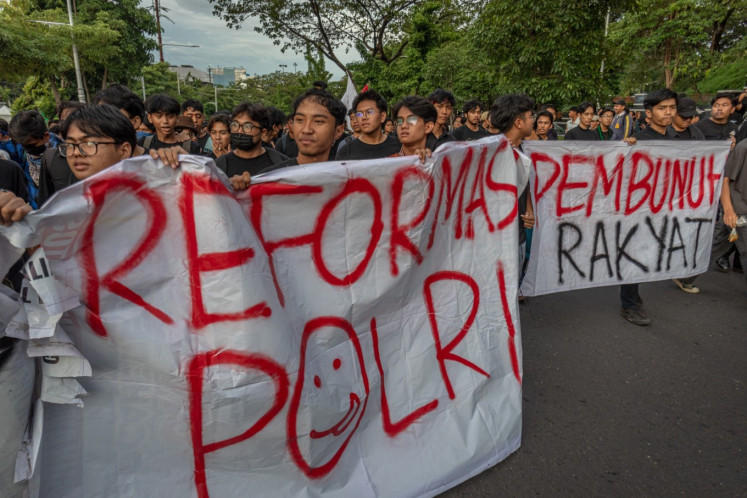Popular Reads
Top Results
Can't find what you're looking for?
View all search resultsPopular Reads
Top Results
Can't find what you're looking for?
View all search resultsOnce was a beach
Canvas for self-expression: Some of the walls of a former beach warung still stand on the beachIn great biting gulps the sea is devouring beaches along Bali’s east coast
Change text size
Gift Premium Articles
to Anyone
C
span class="caption" style="width: 398px;">Canvas for self-expression: Some of the walls of a former beach warung still stand on the beachIn great biting gulps the sea is devouring beaches along Bali’s east coast.
In little over a decade more than 100 meters of beach has been lost to wave erosion at Lebih beach; houses, warungs, a meeting hall and temples have disappeared under the unstoppable seas.
Today the cement carcasses of warungs litter this holy beach, their cement roof bearers and uprights collapsing on the sands like the bones of some prehistoric dinosaur. At low tide the remains of concrete walls appear like blackened teeth in the mouth of the sea, which daily with the high tide eats away more of this coastline.
It is not only the physical environment that has been lost. For as long as anyone can remember, Lebih beach has been a place of holy pilgrimage with more than 10,000 people streaming to the beach for the annual Samuan Tiga Melasti Hindu rights, origins of which stretch back over a millennia, according to local Hindu priest, 57-year-old Mangku Segara Lebih, whose name translates from Balinese as Lebih sea priest.
“It’s like this — the sea used to be a long way out — we have measured the loss and the sea has encroached by 105 meters. In the past there was plenty of room for the more than 10,000 people who came here for the Samuan Tiga ceremony. This beach was long ago named the most holy of all Gianyar’s beaches, sacred for these rights. Now, with the loss of the beach there is no space for the people so we have had to move ceremonies to Masceti beach, along the coast,” says Segara of the impact of beach erosion on religious traditions.
He is saddened by this break in an ancient chain.
“I feel that for most people Samuan Tiga held at Masceti did not feel like in the past. We feel we have lost our roots — our place of worship — with the forced move to Masceti beach. It does not feel right,” says Segara.
Despite the lack of beach area one ceremony continues to be held at Lebih beach, the twice-yearly Karia Nang Luk Merana.
“This can only be held at Lebih beach. For all the towns of Gianyar, we still must hold this ceremony at Lebih, even though the beach is so narrow these days,” says Segara.
Even the day-to-day rituals at Lebih are disturbed by the grinding erosion of waves on sand.
“Every year we lose 7 meters of beach. Every time the [beach side] altar collapses under the waves we have to move our altar. Every five years we are forced to rebuild 35 meters up the beach. We’ve rebuilt that altar four times now — that means we have lost 105 meters of beach in the past 15 years,” says Segara.
Once, Segara goes on, children swam each afternoon in the sea, catching waves and riding them onto the wide, smooth sands.
“In the past people bathed here. They still swim, but it’s become dangerous. Now you have to be careful because of the concrete and rocks. In the past the waves broke onto the sands, so it was OK, you didn’t get hurt. But now the waves break onto the concrete and rocks, so it could be deadly if you smash into those. People are now frightened to swim,” says Segara.
He adds that even the local fishermen are these days wary of the sea they have lived with and known for decades.
“For the fishermen it’s difficult to launch their perahu [outrigger style fishing boats]. They have to watch for the cement and rocks when they put to sea and when they return,” says Segara.
Local fisherman, Nyoman Soklat, speaking Balinese tells of the impact on people’s livelihoods by the sea’s encroachment on the land.
“There has been a huge impact on us. As fishermen it’s difficult to get our boats in and out to sea. Also the concrete and rocks tears our fishing equipment and damages our boats. In every way this is bad for us. It makes fishing for a living harder,” says Soklat.
On the high tide line, warungs of bamboo stand perched on sandbags; like the Hindu altar, these are moved farther and farther toward the road and away from the sea.
Accepting the situation, the women running the warungs shrug their shoulders.
“No, we are not worried about the sea rising,” says one woman, the corner of her warung buried into sandbags. “When the water comes up it washes away again. It’s no problem,” she adds.
Prayer time: Women offer prayers on a temporary bamboo altar at the holy beach of Lebih in Gianyar.Mangku Segara is of a different mind and recognizes that the continually rising sea is very serious and could in time breach the bypass road still under construction 100 meters or so from the new high tide mark.
“The sea used to be a kilometer from my home [near the bypass]. It’s now only a few hundred meters. I think the government plans to build a wall like they have done in Sanur at Mertasari beach,” says Segara who believes the change in wave action and rising of sea levels is due to the land reclamation of Serangan Island to the south.
“Serangan used to be separated from mainland Bali, but it’s been built up and there is a land bridge now. The island has been enlarged substantially and I believe this is the cause of our higher tides and the erosion this is causing. If you think about it — there is always the same amount of water in the sea, but with more land in the sea, from Serangan, the water has to rise,” says Segara, who for now can only hope that in the future children attending the Samuan Tiga ceremonies in Masceti beach will hold that place sacred as their ancestors once held Lebih.
“At my age this move is not good, but for the children, in years to come, Masceti will feel like the normal place for this special ceremony.”











